
Andrea Durham, MBA’90, of Science World
Andrea Durham’s affinity for museums began as a child with a visit to the Museum of Science and Industry in Chicago, where she loved journeying underground in the realistic coal mine exhibit. In her family, vacations included stops at historic homes and churches, a custom she grew to love. Later, as a mother, Durham, MBA’90, would take her newborn daughter to an exhibit of Claude Monet’s paintings at the Museum of Fine Arts in Boston. “She would sit in my arms and just stare at the paintings,” she remembers. “I used to say I was raising a museumgoer.”
So it’s little surprise that 13 years into a career in engineering, technology, and management consulting, Durham was intrigued by a job posting for an exhibit manager at the Museum of Science in Boston. She decided to apply. “I convinced them that they didn’t need someone with museum experience, but someone who was a museum fanatic who had really solid business experience,” she says.

Photo: Johann Wall
Andrea Durham, MBA’90
That job turned into 17 years at the museum, including a role as director of a $20 million National Science Foundation grant to educate the public about nanoscale technologies. Eventually, Durham became the museum’s director of exhibits. “As far as I was concerned, I had pretty much reached nirvana because I had a fantastic job,” Durham says. Then executives at Science World in Vancouver, British Columbia, approached her about an open position at their museum. They won her over, and Durham agreed to join their team as vice president of exhibits, facilities, and digital initiatives. After many years in Boston, Durham, her husband, Karl Jessen, MBA’87, and their two teenagers embraced the adventure of relocating.
Durham describes Science World as “a place where people of all ages go to have a hands-on science experience.” The museum offers a collection of artifacts and a giant T. rex fossil, live animals including a hedgehog and chickens, and one of the world’s largest dome theaters, a landmark in the Vancouver skyline. But its specialty is interactive exhibits where visitors can play and experiment. In the adjacent outdoor science park, staff conduct popular live demonstrations with bubbles, electricity, and exploding soda bottles. Roughly 500,000 to 600,000 people visit each year, including many children under age 12.
Durham oversees the team that plans and executes exhibits. “I think of myself as the coach and mentor who provides inspiration and challenges the team to do their best work,” she says. Staff perform market tests to see how visitors respond to concepts and then work with the exhibit designer to realize the ideas. Each exhibit takes one to three years to develop, and Durham calls this the “super fun part” of her job. One new exhibit—a state-of-the-art, multitouch table that operates like a gigantic tablet computer, allowing visitors to touch and drag ultra high-resolution images that explain the electromagnetic spectrum—is so popular that visitors stop Durham on the museum floor to tell her how much they’ve learned.
Durham oversees the team that runs the museum’s IMAX theater as well, and she confesses to being a little star-struck about the venue. “It’s still a ‘wow’ to see animals and scenery bigger than life,” Durham says. She also enjoys observing visitors as they watch movies. “Being in the theater with school groups, and hearing them gasp and ‘ooohhh’ and giggle, is so delightful.” Her responsibilities include attending the Giant Screen Cinema Association conference, and she was thrilled when Christopher Nolan, director of the film Interstellar and a fan of the big-screen format, gave attendees a sneak peek of his current project, filmed with the big-format equipment.
Despite the occasional red-carpet experience, Durham says she spends much of her days in meetings, discussing everything from long-term strategies to the facilities issues that accompany a seven-day-a-week operation with thousands of visitors. She also has spent much of her career thinking about ways to engage underserved groups. “Demographically, museum visitors are overwhelmingly upper middle-class people,” Durham says. In an effort to attract a more diverse audience, museum staff take their live science demonstrations to far-flung rural schools and events such as farmers markets. “If these groups don’t think of this as a place to bring their kids on weekends,” she says, “that’s another generation of kids who aren’t exposed to how fun science can be. It’s pretty high on my priority list to contribute to breaking that cycle.”
In the meantime, Durham continues to feed her personal love for museums. A recent trip with her teenagers to Los Angeles included visits to the Natural History Museum and the J. Paul Getty Museum. “People laugh and say, ‘Seriously, don’t you ever get enough?’ Well, no,” she says. “I just really believe in museums and what they have to offer communities.”
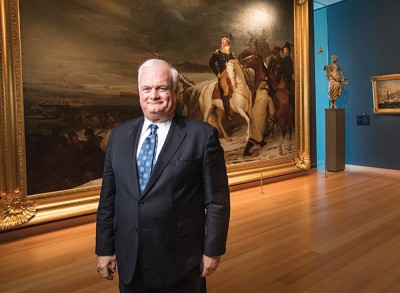
Photo: Tom Kates
Mark Kerwin, MBA’86
More Than Numbers
For Mark Kerwin, MBA’86, no two days at the Museum of Fine Arts in Boston are ever the same. The deputy director and chief financial officer oversees a dizzying array of operations: the financial and treasury functions of the museum and the School of the Museum of Fine Arts, human resources, IT, the museum’s four restaurants, the MFA gift shops and other retail operations, municipal relations, and even the parking garage. “We don’t have the scale of some national businesses,” he says, “but we are a more complex institution than many.”
His position also means managing the sometimes quirky risks that accompany exhibits held at one of the largest art museums in the country. For example, when the museum displayed an installation by contemporary artist Damien Hirst that featured a lamb suspended in formaldehyde, Kerwin and his colleagues held detailed discussions about the potential risks of placing a glass tank of formaldehyde in a public gallery. Last summer, the museum presented Big Bang by Guatemalan performance artist Regina Jose Galindo. The performance involved Galindo driving herself around Boston streets, and then pulling into the museum parking lot and dismantling the car with a blowtorch. Kerwin says he found himself concerned about the possibility of a gas tank explosion (which, he notes, did not happen). “At times like that, I realize I am fully entrenched in a portion of the nonprofit world that operates differently than others,” he says.
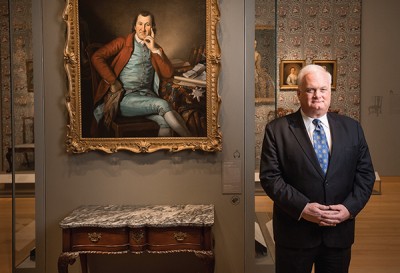
Photo: Tom Kates
Mark Kerwin, MBA’86
Kerwin describes the museum as “one of the great encyclopedic art museums in the world,” with works covering thousands of years, from ancient Egypt to the present. An avid history buff, Kerwin says he is particularly fond of the Colonial portraits in the Art of the Americas wing, a $345 million construction project he helped finance with his team. Now with the MFA for 15 years, Kerwin also was intrumental in a successful $504 million capital campaign and $12.5 million in renovations to the Linde Family Wing, which houses contemporary art.
The MFA is the largest privately funded art museum in the world, notes Kerwin, and its $100 million annual budget features virtually no government grants. (The Metropolitan Museum of Art in New York is larger but receives significant financial support from the city, notes Kerwin.) Roughly 1.1 million people visit the MFA each year, although various factors can affect that figure; admissions may fluctuate with the economy, for example. “Museums are by their nature a discretionary spend,” Kerwin says. The public can easily choose to go elsewhere, so museum administrators and curators work to keep the collection and exhibitions relevant and interesting. Sometimes that means choosing blockbuster exhibits of popular artists, such as the recent “Goya: Order and Disorder,” which drew more than 200,000 visitors. But Kerwin points out that smaller exhibits, including the current “Gordon Parks: Back to Fort Scott,” which displays the work of the celebrated African-American photographer, play an equally critical role in attracting the public and press.
Kerwin adds that he has watched museums grow more accessible to people without a background in art history. “We have worked very hard to remove barriers, intellectual and otherwise,” he says. “Our mantra here is that art is for everyone.” The MFA also has led the industry in its efforts to put photos and information about its collection online. In some circles this is controversial. Critics say virtual tours can discourage people from coming to see the art in person, but Kerwin disagrees. “We’re not fearful of that,” he says. “Part of our cultural and educational mission is to explain our collection, whether visitors are paying a fee at the front door or not.”
Kerwin is passionate about the MFA’s mission. “I tell people we’re part of the cultural heritage of this country,” Kerwin says. “To preserve and protect a collection going back thousands of years, well, in the quiet of the night, it’s a nice thing to know you’re part of it.”
An Entrepreneurial Approach
Sam Aquillano, MBA’14, wanted to convert people to the gospel of good design, but he felt that he was preaching to the choir. He spent nine years at Bose designing speakers and home entertainment systems, taught industrial design at Wentworth Institute of Technology in Boston, and ran the local chapter of the Industrial Designers Society of America. “But I felt like I was only talking about design to other designers,” Aquillano says. “It was a conversation that deserved a broader audience.”
Aquillano believes that thoughtful design can solve real problems and make objects and experiences better for human beings. He says many people misunderstand what the term “design” even means. “They think it’s just curtains and upholstery,” Aquillano says. But it’s also a way of approaching problems. “If you start by thinking about what people need, what people want, what makes them happy, what’s going to solve a problem in the most efficient, useful, beautiful way, then the result is usually good design,” he says. He cites cars as an example: Does the steering wheel feel good? Are the windshield wipers easy to find? Can the driver see out the back window? A well-designed car can be a source of joy for the driver, says Aquillano.
He and his business partner, fellow industrial designer Derek Cascio, talked about establishing a museum where visitors could see exhibitions of standout design and the process behind it. But the year was 2009, the economy had crumbled, and they couldn’t secure grant money for a building. That’s when they began noticing vacant retail spaces and other empty public spots and landed on a novel solution: They would exist as a pop-up, nomadic museum, with their exhibitions appearing for short periods in locations around Boston.
Aquillano left Bose to launch the Design Museum of Boston. Soon he was planning the first exhibition, which celebrated designs created by Boston firms. Displays included an architectural model of a massive chiller plant, a collection of Oxo barware, and a gown from a local fashion designer. He and Cascio brainstormed locations to match the exhibition topic and landed at Boston City Hall. Another early exhibition on the role of design in travel was held in a cavernous concourse in Terminal E at Logan Airport
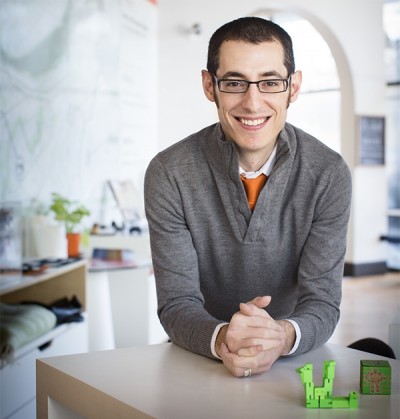
Photo: Tom Kates
Sam Aquillano, MBA’14
The pop-up concept solved two problems. “The biggest line items on a museum’s budget are facilities and marketing, and we didn’t have either,” Aquillano says. He cultivated relationships with facility managers and real estate developers, convincing them that hosting the exhibitions would generate foot traffic and positive attention. For the City Hall and airport exhibitions, captive audiences meant less money spent on advertising. The pop-up model continues to work; Aquillano says the museum has never once paid for exhibition space. This also has changed the way he and his team look at the city. “When I walk around the city and I’m in new places, I’m always thinking, ‘Wow, that could be a great exhibition spot.’”
One of the biggest tasks for Aquillano’s team is curating the exhibitions. The museum does not yet employ a curator—“we’re still so small,” Aquillano says—so he relies on advisory committees of people with subject matter expertise to recommend topics and artifacts. The museum staff then sets to work gathering materials, which can take up to a year. For the Logan exhibition, they worked with Samsonite to locate vintage luggage. They scoured eBay for old plane tickets, contacted private collectors of travel posters, tracked down a cherry red 1960s-era flight attendant uniform, and asked a museum board member to loan his collection of complimentary in-flight pajamas, given to passengers long ago on overseas flights. Aquillano thinks of curating as “modern archaeology.”
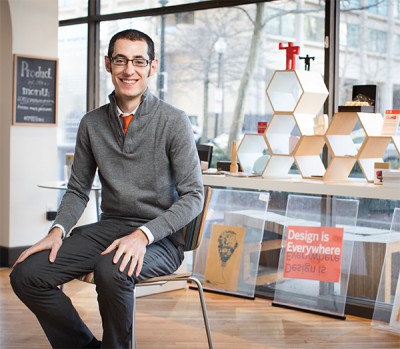
Photo: Tom Kates
Sam Aquillano, MBA’14
In 2012, the museum was chosen to take part in MassChallenge, a business accelerator designed to help startup companies expand. “Our mentors were really pushing us to grow the museum, and I pitched to our board this idea of growing to different cities,” Aquillano says. “Obviously, good design is everywhere, not just in Boston.” This led to the launch of the Design Museum Foundation, a nonprofit 501(c)(3). The first satellite opened in Portland, Ore., in October 2013, and the second launched in San Francisco this January. The foundation now employs seven people and hosted roughly 370,000 visitors in 2014.
As the foundation’s executive director, Aquillano has a main focus these days: fundraising. “One of the challenges is shoehorning our kind of museum into the traditional funding models,” he says. Most major museum fundraisers are capital campaigns focused on renovations or building a new wing, a problem for a museum with no building or galleries that can be named after major donors. The foundation’s largest source of current funding is program sponsorship, and, ultimately, Aquillano hopes his position or a future curator position will be endowed by a major donor. The foundation also benefits from its member program; for their annual fee, members receive access to opening night receptions and other members-only events. “Every day we’re getting better at the fundraising process,” Aquillano says.
He’s proud of the museum’s smallest successes. “I find it thrilling every two weeks when I pay my staff,” he says. “I think, ‘We’re doing this!’” And he remains passionate about design as a force for good. “I absolutely see design as a practice that can change the world.”
Breathing Life into History
Sometimes the humblest objects—a lantern, a desk, a musket—can bring dry, historical facts to life, says Susan Gladstone, MBA’85. She and her colleagues at the Concord Museum in Massachusetts are committed to ensuring that visitors, especially children, can see such artifacts up close.

Photo: Tom Kates
Susan Gladstone, MBA’85
“The museum is about Concord history, but it’s really the history of America,” she says. The collection includes one of Paul Revere’s famous “one-if-by-land” lanterns, the books and furnishings from Ralph Waldo Emerson’s study, and the desk where Henry David Thoreau wrote Walden and “Civil Disobedience.” Gladstone says the desk, which sat in Thoreau’s cabin at Walden Pond, is her favorite object in the museum. She notes that if visitors look closely, they can see the paint worn away around a keyhole, proof that Thoreau regularly locked his desk, even though he famously wrote in Walden that he never locked his cabin door.
As director of development, Gladstone is chief fundraiser for the museum, which was founded in 1886 and welcomes about 40,000 visitors each year. People often assume that the town of Concord funds the museum, but it does not. “We’re a town treasure,” says Gladstone, “but we’re not town-supported.”
She and her team raise the money needed to support the annual fund, as well as exhibitions, special programs, and capital projects. Recently, Gladstone played a key role in funding and launching the Paul Revere’s Ride Fund, which covers the cost of bus transportation and fees for Massachusetts schools that can’t otherwise afford field trips. The museum launched a pilot program for the 2014-2015 school year with the fifth-graders from Lowell, Mass. “By the time spring comes, all of their fifth-graders, more than 1,000 kids, will have come to the museum,” Gladstone says. Raising funds for this project was particularly rewarding. She found individual donors interested in helping underserved populations, and she and a team created a live auction for the museum’s annual gala event. “We received generous support very quickly,” Gladstone says.
But the fundraising process isn’t always so straightforward. Gladstone and her team often begin a whole year before an exhibit is staged, brainstorming a list of prospects to approach for support. She gives the example of “The Art of Baseball,” a current exhibit of baseball memorabilia curated by historian and baseball fan Doris Kearns Goodwin. “We approached a completely different set of potential supporters than we would for our previous exhibition on the sculptor Daniel Chester French,” Gladstone says. “It gave us the opportunity to reach out to foundations, like the Yawkey Foundations, and others that wouldn’t ordinarily be interested in the museum. It’s a good example of why we like to have two changing special exhibitions each year,” she says. Each exhibition provides a fresh opportunity to attract new and returning visitors, as well as new potential supporters.
When it comes to approaching potential donors and sponsors, Gladstone says she lives by this maxim: “If you don’t ask, you’ll never get a yes.” But, she adds, “You have to be ready for a no, or my favorite, the person who ignores you and never responds.” Rejection is part of the process, she says. “Sometimes you need time to gather your courage again, but most of the time you just move on quickly.”
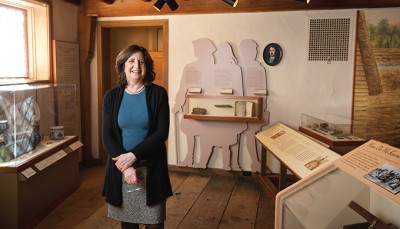
Photo: Tom Kates
Susan Gladstone, MBA’85
Gladstone entered the world of nonprofit development after more than two decades in high-tech marketing and product management, and she found that her corporate skills, including project management, applied well to her new work. Before joining the museum, she spent 10 years in a development position at The Concord Free Public Library, where she led a successful $10 million campaign to renovate two of the library’s historic buildings. These job changes have been more than career moves for Gladstone; she and her husband have lived in Concord for 20 years, raising two daughters. She loves the community and enjoys working with her colleagues to share the town’s rich history.
One of the fun parts of her job is watching visitors react to the objects they encounter, including the lantern that played such an important role on the night of Paul Revere’s ride in 1775. “Visitors come in and say, ‘That cannot be the real lantern,’” Gladstone says, chuckling. “But it is the real lantern.”
